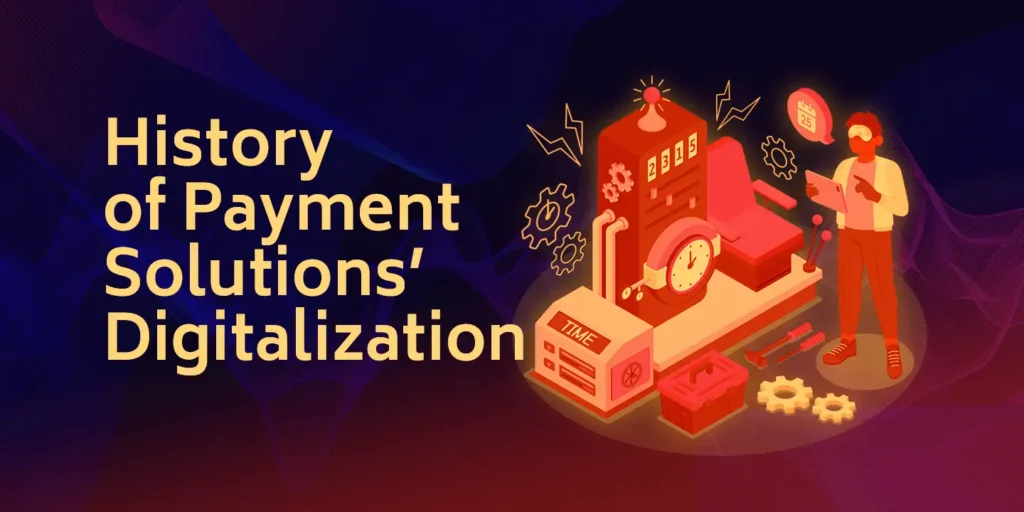Is there room to further innovate the FinTech industry? It is indeed not merely limited to the banking sector but is fueling the entire economy, thriving at the intersection of the public sector with legal constraints, design thinking, engineering with user experience enhancements, and various financial operations using complex mathematical models.
History of Payment Solutions’ Digitalization
The term “FinTech” first appeared in a 1967 article in The Boston Globe titled “Fin-Tech New Source of Seed Money,” where it referred to a startup investment firm focused on supporting companies in the financial technology sector. Despite this early mention, the term didn’t gain widespread use until the 1990s, when Citicorp Chairman John Reed used it to describe the Financial Services Technology Consortium. This Citigroup initiative promoted technological cooperation within the financial industry, marking a key moment in the evolution of financial technology and collaboration across the sector.
There wasn’t one instant seamless switch from paper paychecks to contactless payments using portable devices.
A key milestone in the electronic money movement occurred in 1918 with the establishment of the Fedwire Funds Service by the Federal Reserve Banks. This early electronic funds transfer system relied on telegraph lines to securely transfer funds between member banks, marking one of the first instances of electronic financial transactions. In 1950, Diners Club International introduced the first universal credit card, revolutionizing consumer spending and credit. This innovation led to the launch of American Express cards in 1958 and BankAmericard (which later became Visa) in 1959, laying the foundation for modern payment systems.
A significant milestone was the introduction of Secure Sockets Layer (SSL) encryption in the late 1990s.
Another well-known technology, Near Field Communication (NFC), was first patented back in 1983. Originally used in Hasbro’s Star Wars characters, it appeared in mobile devices by Nokia, Phillips, and Sony in the mid-2000s.
Benefit #2. Cost efficiency
Customers using cloud solutions benefit from a pay-as-you-go model, accepting costs only for the resources being actively used and not the entire on-premises infrastructure with capital investments in servers, storage, human resources, and networking equipment, not to mention the ongoing costs of maintenance, upgrades, and energy consumption. Moreover, moving towards the economies of scale, cloud-based companies can spread the cost of infrastructure and maintenance across a wide customer base, thus lowering costs for organizations and units within them.
Despite being a costly undertaking per se, cloud migration abrogates initial investments thanks to scaling customer base and extending product lifecycles.

Key FinTech Trends and the Future of Payment Gateways
- Biometric Authentication: The use of biometric methods like fingerprint and facial recognition is expected to grow, offering more secure and user-friendly ways to verify transactions.
- Blockchain and Cryptocurrencies: Blockchain integration could revolutionize cross-border payments, making international transactions faster and more transparent through the use of cryptocurrencies.
- AI and Machine Learning: Payment gateways are likely to adopt AI and machine learning to detect and prevent fraud in real time, enhancing overall transaction security.
- IoT Payments: With the rise of the Internet of Things (IoT), payment gateways might be embedded into smart devices, enabling seamless, connected transactions.
- Voice-Activated Payments: As voice assistants gain popularity, voice-activated payments could become a common way for users to make purchases using simple voice commands.
- Real-Time Payments (RTPs): RTPs are transforming the payment landscape by enabling merchants, consumers, and financial institutions to conduct transactions instantly and securely. This immediate initiation and settlement of RTPs offer businesses improved visibility into their payments, enhancing cash flow and operations management.
eCommerce continues to be a dominant trend in the payment space, showing no signs of slowing down. Global online retail transactions have surged, with China leading the way. In 2020, China’s online retail sales reached $2.29 trillion, projected to grow to $3.56 trillion by 2024. The COVID-19 pandemic has accelerated the shift to online shopping, with nearly all merchants establishing an online presence. A leading online payment solution provider reported an 80% increase in transactions in 2020 compared to the previous year.

What About Us?
The cornerstone of Lerpal methodology in the FinTech realm is never sacrificing usability for security and vice versa, putting the user first while complying with and anticipating future developments in PCI DSS in the United States, GDPRin the European Union, and the United Kingdom Data Protection Act. Our versatile portfolio includes contributions to growing products like Vertex, Orbital by JP Morgan, Vantiv (Little & Co.), Cybersource, and Spreedly, a Global Payments Orchestration Platform.

FAQ
FinTech (short for financial technology) describes new technology that seeks to improve and automate the delivery and use of financial services. At its core, FinTech helps companies, business owners, and consumers better manage their financial operations. FinTech now includes sectors like retail banking, fundraising, investment management, and cryptocurrency development.
A payment gateway is a technology that enables merchants to accept debit or credit card payments from customers. This includes both physical card readers and online payment processing portals. In recent years, payment gateways have evolved to support mobile payments via QR codes or NFC technology through smartphones, providing a seamless payment experience.







